
by Bettina Shultz-Jobe, LPC, NBCC | May 20, 2022 | The Latest in Equine Assisted Therapy and Learning
Natural Lifemanship® has evolved—and our new branding reflects these changes. It is my deepest hope that these changes stir a transformation in you. For decades, we have shared our unique principles with clients and practitioners around the world, teaching the power of connected relationships and watching with awe and wonder as our world heals and grows one relationship at a time. While our practice and teaching is ever-evolving, moving with each new shift in the universe, and adjusting to the impact of those shifts on the mental health and wellness of our communities, the platform from which we shared our work became outdated. Our website did not offer enough guidance for professionals to find the tools and trainings that would best meet their needs. Although many have found what they needed, and began a journey with us, we often received feedback that the process of committing was time-consuming and confusing. This has changed. The breath that comes into my body when I say that is lovely, so I’ll say it again. THIS. HAS. CHANGED!
Our Tagline is an Invitation
As we move into this exciting chapter, we invite you to “walk with us.” Our tagline acts as an open invitation for those who wish to build their life and practice on a foundation of essential principles. With a principle-based process, the journey of learning is ongoing – we will walk with you every step of the way. Our trainings are designed to meet you where you are and guide you to where you want to go – there is no “one size fits all” approach. Our seasoned trainers are ready to support your unique personal and professional growth.
Our Logo is a Symbol of Who We Are, Together
Developing a logo is a process of exploring one’s identity – when we began creating our new logo, the NL team members each saw something different. It was intended to be a hoof, but the image allowed us to also see a thumb print, ripples in the water, as well as a representation of movement in general. The abstract nature of our logo is intentional – we have created something we hope you will identify with, no matter where you are on your journey. Whether you see the hoofprint of the remarkable equines with whom we share this process, or the ripples of healing that we as practitioners initiate in our field of work, or something else entirely…we do not just welcome you to NL, we are building our organization with you in mind.
The Look and Feel is Grounding
The earth tones we have incorporated into our brand are reflective of our love of and belonging in nature, and our continual pursuit of a grounded approach to healing. The feel of our new site is a reminder of the landscape that shelters us, the plants and animals with whom we share our lives, and in particular, the equines with whom we have the privilege of being partnered. We are committed to continuing our evolution – to always growing so that we are better prepared to nurture your growth. Together, we can create ripples that spread far and wide.
We Have a Path for You
When you visit our site, you will see a deep commitment to the Equine Assisted Services (EAS) field and an opportunity for you to start or continue your EAS journey. A quiz has been designed to help you better understand your needs and how Natural Lifemanship can support you. We’ve designed an interactive experience on our training page where you can choose one of four designated training paths, or create your own. Our certification path is simplified and clear, and NL membership is offering more community and live contact and support from our trainers (including Tim and me) than ever before. Additionally, we’ve included videos and testimonials throughout the site to explain what sets us apart, and why that matters to your life and practice. See our evolution for yourself and learn how we can support you on your own unique and sacred journey. We are so honored to get to walk with you!
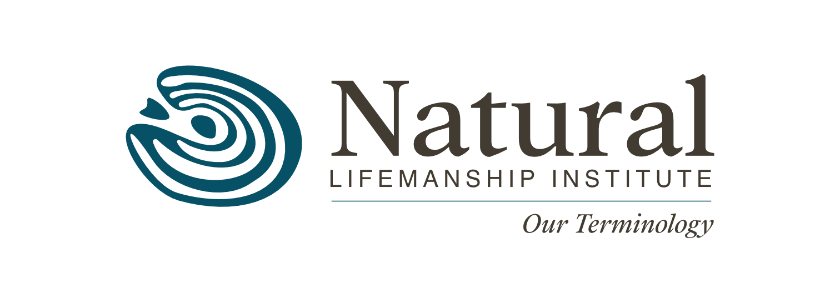
by Kate Naylor | May 9, 2022 | The Latest in Equine Assisted Therapy and Learning, Uncategorized
In any professional field, there are always going to be a slew of terms and acronyms that are routinely used that are unfamiliar to those not in the field. It can unintentionally create an “insider” and “outsider” feel for a person.
We don’t want “insiders” and “outsiders”.
While we do need to be accurate and ethical in our description of services and qualifications, it is our sincerest desire that you feel welcomed, that you feel you belong here, and that you can find your way around. It is also of utmost importance to us that our clients and consumers have the same experience when seeking a professional.
At The Natural Lifemanship Institute, we believe that how we talk about what we do matters. The language we choose to use reflects our intentions, based on our values of connected, healthy relationships.
In order to help you orient not only to the field of equine assisted services at large, but to how Natural Lifemanship specifically speaks about these services, we have created this table. Below you will find the terminology NL uses and our recommendations for how you use this terminology in your practice as you grow with us.
The following diagram explains the collective term of TI-EAS, as well as the more specific modalities of TI-EAT, TF-EAP, and TI-EAL.
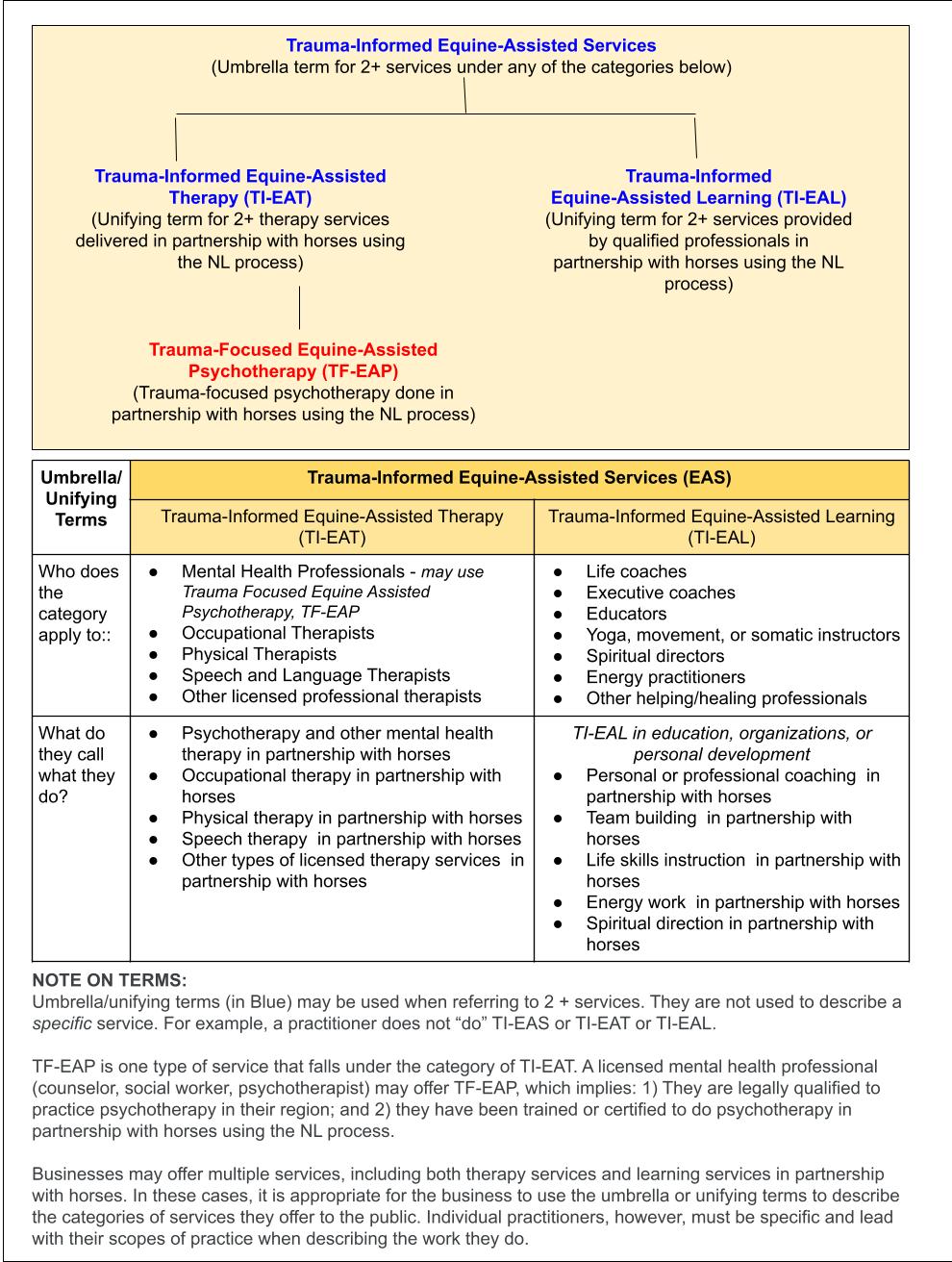
TI-EAS is the unifying term we use for all the modalities we certify professionals to practice through Natural Lifemanship. TI-EAS stands for Trauma-Informed Equine Assisted Services and encompasses all the myriad ways professionals can partner with horses in healing or learning environments. This is a collective term––so there are subsets when we get into the specifics of scope of practice and skill sets of the individual professionals guiding the sessions.
Scope of Practice is one’s own limit of skills, knowledge, and professional experience––made up by the activities routinely performed within one’s professional role. One’s scope of practice evolves as new knowledge and experience is acquired through continuing education.
This means that within the umbrella term of TI-EAS, there are a few options for how you would describe your work, and these descriptions are entirely dependent upon your other skills that you bring outside of your training with NL. Natural Lifemanship training alone does not prepare you for doing ethical work with people – it is a perspective and an approach that supports you in being trauma-informed for both humans and horses (and other animals) as you provide the services your other skill sets allow you to provide.
For example, an equine professional can become a Trauma-Informed equine professional (aka Natural Lifemanship certified equine professional) through our training, and will be prepared to assist a therapist, coach, educator, etc in bringing horses into healing/learning sessions with people – or the equine professional can obtain additional training in coaching/education/therapy/etc to provide services solely on their own. Natural Lifemanship training will not prepare an equine professional to become a coach, therapist, or other kind of educator. Visit our certification page to dig deeper into the different paths offered.
A certification with NL does provide a trauma-informed lens for partnering with humans and horses, and pairs with any number of other professions (examples are in the table above) to offer healing/learning sessions to humans.
We use the term “Trauma-Informed” no matter the scope of the professional we train, because our expectations of trauma competency do not change from one practice to the other–– it is our belief that being trauma informed (the details of which you will learn throughout your training with us) is a basic requirement for providing competent and ethical care to anyone. A foundation of knowledge in the science and research that has created trauma informed practices are essential to effective and ethical healing work – therefore our approach to equine assisted services is always trauma informed, no matter who is conducting the session.
How you specifically apply your learning with NL (whether it be therapy, coaching, learning, etc) is largely addressed through practice and consultation, as well as discussion with mentors and supervisors during and after training. Throughout your certification process you will be supported in applying your learning to your specific skill set and scope of practice. The knowledge needed and taught during our trainings will be the same for everyone; the applications of what is learned will be unique to you.
All this terminology can be a little dizzying. Ultimately, it is our hope that this evolution of language in our field will help you find your place here in Natural Lifemanship – one that is relational, ethical, and clear.
We will walk with you every step of the way.
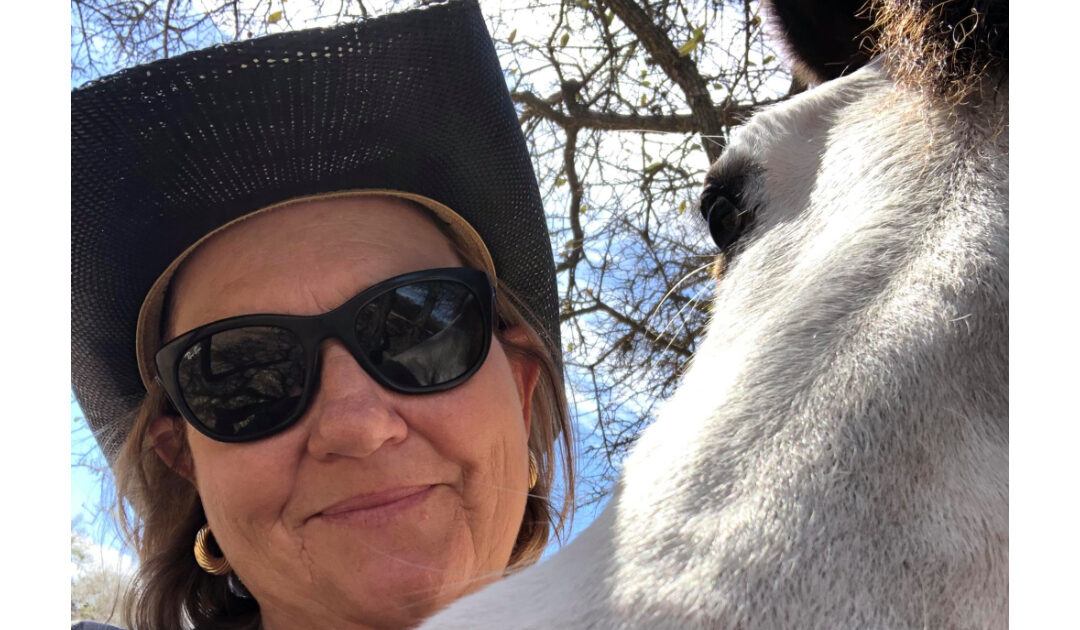
by Kate Naylor | Mar 18, 2022 | Applied Principles, Basics of Natural Lifemanship, The Latest in Equine Assisted Therapy and Learning
Recently, I was watching the inspiring Netflix series Queer Eye, a heartwarming reality show that focuses on supporting people in reconnecting with themselves. This year Queer Eye filmed in my hometown, Austin Texas! Double joy!
Not only did I get to see humans being good to humans, but they were my dear Austin humans!
Imagine my excitement when on episode 7, “Snow White in Central Texas”, the Queer Eye team introduced us to an incredibly selfless woman named Jaime who runs an animal rescue, “Safe in Austin” – and lo and behold, one of the wonderful opportunities presented to her in the episode was a chance to participate in Equine Assisted Learning with a Natural Lifemanship trained professional! Let me explain.
About the cast of Queer Eye
On Queer Eye there are five cast members, each responsible for a different aspect of the makeover process. One of the cast members, Karamo Brown, a former social worker, always helps the guest of honor get in touch with the emotional aspects of the makeover.
In this episode, Karamo took Jaime to a resort called Miraval, for rest and relaxation, as well as an equine experience with the talented Leigh Wright! Leigh has been learning with Natural Lifemanship since 2019 and her understanding of our approach is made clear in her facilitation of Jaime’s session.
A quick recap of what Natural Lifemanship does
At NL, we teach professionals a principle-based approach to Equine Assisted Services, based on the science of relationships, that can be integrated into their work with clients.
At the beginning of her session, Jaime was introduced to several horses and encouraged to feel into choosing which horse she wanted to work with. This is an approach NL advocates for, as it allows a real connection to begin to unfold between horse and human that is fully of their own making. Rather than Leigh choosing a horse for Jaime, Jaime got to experience the emotional process of choosing for herself.
Once chosen, Jaime and her horse entered a round pen in order for both to move freely while the two got to know each other.
Freedom of movement is so important for both the horse’s and Jaime’s regulation, as well as a part of freedom of choice – a fundamental principle of Natural Lifemanship.
Jaime and the horse both needed to be able to move into and out of proximity of one another in order to take care of themselves, regulate, and make choices. Jaime described how in her life she cared for everyone else, often putting herself last. Leigh encouraged Jaime to practice “making a request”.
What makes this unique to NL?
In Natural Lifemanship, making a request is the crux of the work. While it is enjoyable and often soothing to be near a horse and ask for very little (except perhaps allowing petting!), it is when we decide to make a clear request that vulnerability enters the equation. This is when we begin to really feel the sensations and emotions of what it means to be in a relationship.
When we ask for something, we are allowing the other to have an impact on us, we are communicating a need, and have to wait for the response. To do so, without assuming control of the whole dynamic, can feel daunting and bring up powerful feelings.
As I watched Jaime navigate this truth for herself, I was struck by how impactful this moment can be. Leigh offered kind and empathic support, while also observing Jaime’s difficulties to bring them into her awareness. As they continued, Leigh also suggested that Jaime might try asking for space – using the word “detachment”. Considering what I learned earlier in the episode about Jaime taking on the weight of the world and leaving her own care at the absolute bottom of her list – I thought this was another powerful insight from Leigh.
Diving deeper into “connected detachment”
Jaime really did not want to ask for “detachment” – the word coined by Natural Lifemanship to describe the aspect of a relationship that requires some structure and separation, while still maintaining an internal sense of connection (rather than constant nurture and physical closeness).
Detachment is often difficult for people (and horses!) because when we create space between us, we have to trust that our connection can still be strong. Jaime bravely practiced this in her session, and with Leigh’s warm support, she was able to ask for space and still maintain a connection! Confidence lit a smile on Jaime’s face afterwards!
In this small amount of time together, Jaime felt, in her body, what it meant to make a request of others and ask for space when needed – all without hurting the relationship she had begun with her horse. It was eye-opening for her. A beginning, of course, but a good beginning!
While Leigh has studied other models and uses her own blend of approaches, her integration of Natural Lifemanship principles into her work was a pleasure to see.
Way to go, Leigh!!!
You can integrate the NL approach into your life and practice
What we teach at NL is not a specific series of techniques or activities or interventions. Learning Natural Lifemanship means learning principles and the science of relationships so that you can integrate it into your practice in the way that best serves you and your clients.
Want to learn more about Natural Lifemanship and the principles used in Queer Eye? We would love to connect with you! Registration for the Fundamentals of Natural Lifemanship opens soon!
Thank you, Leigh, for your poignant demonstration of an Equine Assisted Learning session!
Thank you, Queer Eye, for bringing the power of Equine Assisted Activities to the public!
Want to support the incredible work of Safe in Austin?
Please visit their donations page.
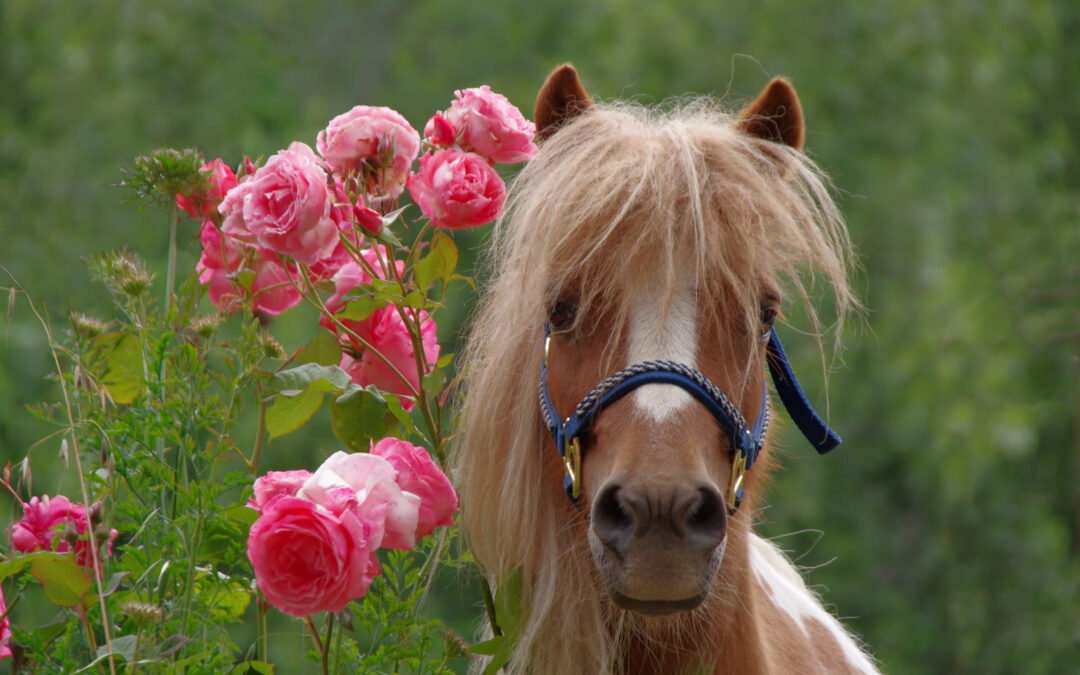
by Laura McFarland | Dec 16, 2021 | The Latest in Equine Assisted Therapy and Learning
“What’s in a name? That which we call a rose by any other name would smell as sweet.”
And be just as thorny….
Okay – I’ll admit I added that last part to Juliet’s musings. She was obviously too lovestruck to think about thorns.
But seriously, names may be, well, nominal, but they do carry meaning and the way they are used can be consequential in both intended and unintended ways.
Here at the Natural Lifemanship Institute, we have been contemplating, discussing and discerning our response to the terminology debate initiated by the consensus document.*
*Not sure what the “consensus document” is? We summarized and discussed the article in our blog published on April 16th, 2021. You can also find a link to the original article there.
As promised, we are ready to share our response and how we arrived at the choices we are making with respect to how we talk about what we do, and what we teach.
If you’re not familiar with the context for this discussion, please read our blog published April 16th, first. Keep reading for a summary of the recommendations in a nutshell.
The Consensus Document’s Recommendations in a Nutshell
- Equine-assisted Services is the optimal unifying term when referring to two or more services. It is too imprecise to be used to describe one program or distinct type of service. Equine-assisted services include:
- Therapy services. Therapy is conducted by licensed professional therapists in any of these fields: counseling, occupational therapy, physical therapy, psychotherapy, and speech-language pathology. Therapists should always use therapy-first language (e.g., physical therapy using equine movement, psychotherapy incorporating horses, occupational therapy in equine environments) when referring to their services.
- Equine-assisted learning is a subcategory of EA services inclusive of three types of non-therapy services conducted by qualified individuals. Recommended terminology refers to the context for learning: Equine-assisted learning in education, equine assisted learning in organizations, and equine-assisted learning in personal development.
- Horsemanship includes four types of non-therapy services delivered by qualified individuals. Recommended terminology refers to the particular sport or horsemanship activity: Adaptive equestrian sport, adaptive riding or therapeutic riding, driving, and interactive vaulting.
- The working group recommended discontinuing the use of imprecise, inaccurate, or misleading terminology, including: equine therapy, equine-assisted activities and therapies, equine-assisted therapy, equestrian therapy, hippotherapist, hippotherapy clinic or program, horse therapy, horseback riding therapy, and therapy riding.
See this illustration for the consensus document recommendations at-a-glance.
Our Response to the Recommendations
Our team at the Natural Lifemanship Institute first wishes to acknowledge those whose considerable efforts and participation in a lengthy consensus-building process culminated in the consensus document. Theirs was a laborious and much needed contribution to the field of human services incorporating horses. We couldn’t agree more with the need for precise and accurate terminology in our field, as suggested by the title of our aforementioned blog article summarizing the document. We agree with many of the recommendations that resulted from the project. We also have a somewhat different perspective on what makes terminology usage in our field problematic and what choices in terminology could be made going forward.
For those who prefer that we cut to the chase, we’ll first share our preferred terminology for services using the Natural Lifemanship (NL) process and for the professionals who provide those services. Next, we’ll share a little bit about our perspective on the subject of terminology in our field and our rationale for making the choices we are making in light of the consensus document.
What terms are we changing or adopting, in a nutshell?
We are adopting the use of an umbrella term (TI-EAS) plus two other unifying terms (TI-EAT and TI-EAL) to distinguish categories of services. The image below depicts the relationship between the umbrella term, the unifying terms, and the specific term (TF-EAP) that represents the work of our founders and many of our students.
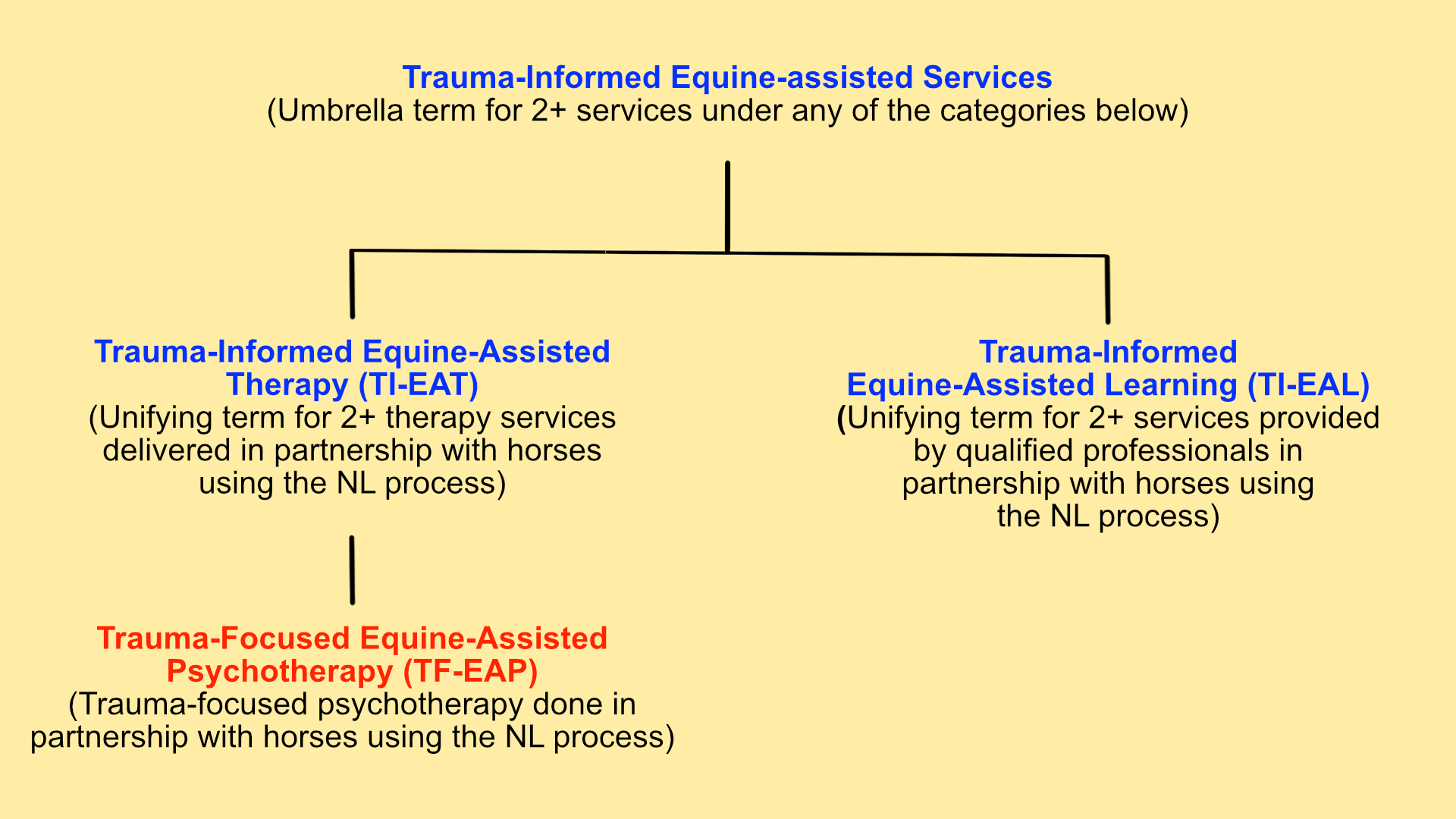
Definition of Terms
Trauma-Informed Equine Assisted Services (TI-EAS) – umbrella term for two or more Natural Lifemanship driven services that fall under the categories of therapy or learning (see below).
Trauma-Informed Equine Assisted Therapy (TI-EAT) is a unifying term for multiple kinds of therapy provided by qualified, licensed professionals. This includes mental health therapy, occupational therapy, speech and language therapy, among others. Trauma-Focused Equine Assisted Psychotherapy (TF-EAP) is one type of service included in the TI-EAT “bucket”. TF-EAP may only be used by licensed mental health professionals trained in Natural Lifemanship. We always recommend that in communicating with clients or potential clients, therapists should be even MORE specific about the work they do within their specializations.
Trauma-Informed Equine Assisted Learning (TI-EAL) is a unifying term referring to learning, personal growth, and wellness services employing Natural Lifemanship. This includes life coaching, energy work, education, and yoga instruction, to name a few examples. This also may include some of the types of work presented in the consensus document under the category of “Horsemanship”, for example, Therapeutic or Adaptive Riding.While many of our students enhance their therapeutic or adaptive riding programs through their learning with us, adaptive riding for those with diverse needs is not our specialization.
Equine Professionals
- The consensus paper did not address the role of the Equine Professional (EP). However, we feel it is critical to address the scope of practice, expertise, and the role of equine professionals in EA Services. Equine Professionals are an integral part of the success of Equine Assisted Services – however, being an EP alone does NOT prepare one to deliver equine-assisted services, which requires professional preparation in one of the human services. An equine professional who wishes to offer equine-assisted services must either partner with a qualified provider of a human service or they must gain the required professional preparation themselves. While our trainings are very heavy on the relationship between horse and human, we hope to further address the specific development of an Equine Professional in future writing and programming.
How to communicate with clients using our new terminology
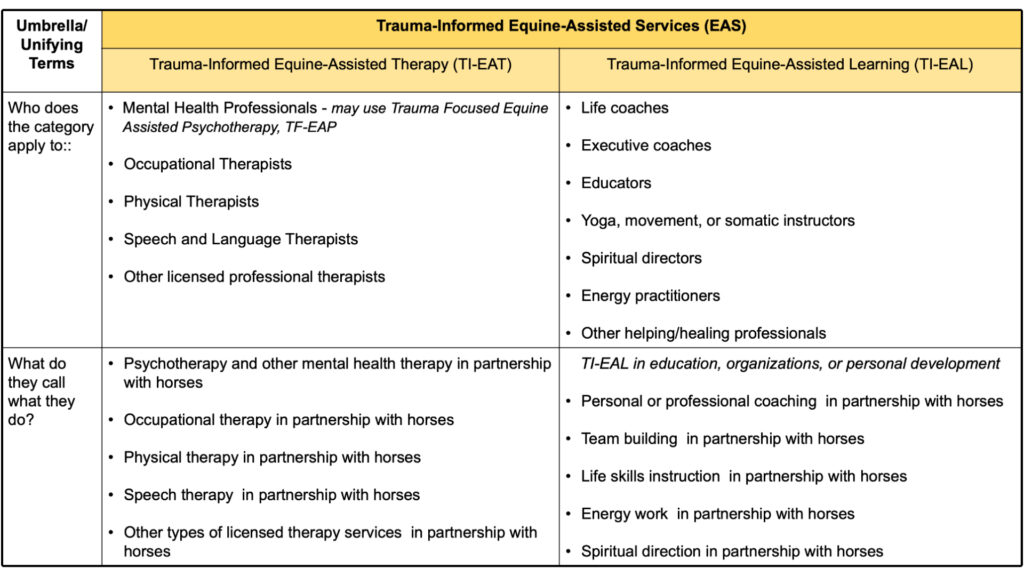
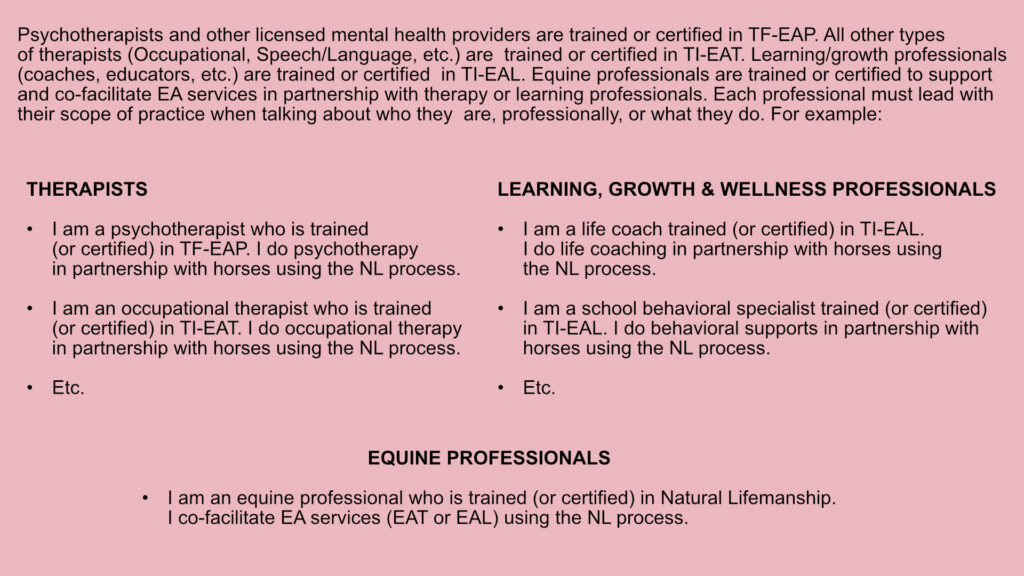
Is NL “Trauma Informed” or “Trauma Focused”, or both?
The Natural Lifemanship Institute teaches a principle-based and process-oriented approach to helping humans in partnership with horses. This principle-based approach is informed by the relational sciences, attachment theory, and the neurobiology of trauma and healthy brain development.
We describe the NL process as being “trauma informed” because regardless of how or where it is applied (i.e., in therapy or in learning contexts), Natural Lifemanship is based on (informed by) the science of trauma and attachment. Trauma-informed approaches such as Natural Lifemanship may be employed for non therapeutic purposes. Somebody who provides Trauma Informed Equine Assisted Learning (TI-EAL) is not attempting to treat trauma therapeutically. However, they may apply their knowledge of the science of trauma to offer learning and growth experiences that are developmentally sensitive and that emphasize connection.
The Natural Lifemanship approach to incorporating horses in mental health treatment, or equine-assisted psychotherapy, is “trauma-focused”. It is informed by trauma/relational sciences and its focus may be on treating the effects of trauma on mental health. Mental health therapists (psychotherapists, counselors, social workers, LMFTs, etc.) who partner with horses based on the Natural Lifemanship approach are trained in Trauma-Focused Equine Assisted Psychotherapy (TF-EAP).
Why the changes?
The term TF-EAP is appropriate for some, but not all, people who practice NL. We have needed a more inclusive way to distinguish between EA services provided by licensed therapy professionals and those outside of the realm of therapy.
Since 2010, TF-EAP has been used somewhat synonymously with Natural Lifemanship. Reflecting the expertise of our founders, TF-EAP also applied to the vast majority of the mental health professionals and their equine professional partners who initially sought out our trainings. However, now, a dozen years later, the NL approach is employed by a wide variety of professionals who partner with horses to serve their clients, including occupational therapists, speech and language therapists, and physical therapists.
Trauma-Informed Equine Assisted Therapy (TI-EAT) is a more inclusive term pertaining to the set of our students who are licensed to practice some sort of therapy. Similarly,Trauma-Informed Equine-Assisted Learning (TI-EAL) pertains to our students who are qualified to offer transformative growth and learning experiences, such as coaching and team building.
One thing that has not changed is that we have always maintained that one’s scope of practice dictates what any of our practitioners may claim to do once they have been trained or certified in Natural Lifemanship.
We agree with the consensus document that precision is important, that the appropriate use of unifying terms facilitates better precision when talking about specific services, and that specific services need always lead with one’s scope of practice. However we disagree with the suggestion that “equine-assisted” should never be used when referring to any kind of therapy. There is a place for keeping “equine-assisted” so long as it is not used inappropriately. One place we feel that equine assisted should continue to be used is in web-based material, which is found through queries in search engines. Without a recognizable, well-known, unifying term such as Equine Assisted Psychotherapy, many consumers and others engaged in keyword online searches would be unable to find the sites and the content that they are searching for.
We also feel that it is helpful to consumers and other stakeholders to compare and distinguish different types of services by situating them within a larger context. For example, when comparing two different services one might want to know, does this service belong to the category of therapies incorporating horses or does this service belong to the category of learning and growth experiences incorporating horses?
We feel the use of unifying terms such as Equine-Assisted Therapies (EAT) and Equine-Assisted Learning (EAL) greatly helps consumers, researchers, and other stakeholders find the services they seek and make educated distinctions between them. The terms are recognizable and parsimonious for the purposes of searching for and comparing services. When seeking potential providers, the unifying terms make it possible for consumers to narrow their search. It is then incumbent upon the providers to specify what, exactly, they provide based on their professional licensure and expertise.
From now on, when we use TI-EAT we are referring to multiple types of therapy in which providers may partner with horses, based on the NL approach, to deliver treatment. This means that somebody trained or certified in TI-EAT must be a licensed therapist and must have undertaken a certain level of professional development with Natural Lifemanship. TI-EAT includes occupational therapy, physical therapy, speech and other kinds of therapy, while the more specific term, TF-EAP, is a subtype of TI-EAT and is limited to psychotherapists and other licensed mental health clinicians.
TI-EAL continues to represent the types of learning and growth experiential services incorporating horses using the NL approach. Again, practitioners who claim to be doing TI-EAL must be trained or certified with Natural Lifemanship.
Conclusion
In conclusion, we hope that our response leaves the reader with a clear understanding of how Natural Lifemanship uses terms, why we support the consensus document’s recommendations for leading with scope of practice, and also why we feel that precise and accurate terminology is necessary but not necessarily sufficient when there is considerable ambiguity around scope of practice in our field. We need to hold ourselves accountable to a higher level of professionalism in this regard.
To reiterate our position with respect to the consensus document recommendations, we are in agreement with the proposed terms relevant to therapy and learning, with one exception: we propose using equine-assisted therapy (EAT) as a unifying term for the types of therapy identified in the therapy category. Just like the unifying terms, equine-assisted services (EAS) and equine-assisted learning (EAL), equine-assisted therapy is not to be used singularly to label a specific kind of therapy. It is simply a more precise unifying term for the category of services in which qualified therapy professionals incorporate horses within their scopes of practice.
Finally, we feel strongly that there is a need to explicitly address the role of the equine professional within equine-assisted services. It is important to define their scope of practice and the kinds of knowledge, skills, experience, and specific training or preparation they must have to effectively co-facilitate therapy and learning in partnership with horses. Look for more from us in the future on this topic. In the meantime, if you are interested in learning more about the role of the equine professional in Natural Lifemanship-based services, we offer a short course, which you may purchase, here.
About Natural Lifemanship
Natural Lifemanship (NL) is a developmentally-informed, trauma-, and attachment-focused approach to developing and strengthening the human and mammalian capacity to connect. Our TI-EAT and TI-EAL trainings and certifications teach a process for building relationships with horses and integrating horses into equine-assisted services in ways that promote healthy connection for both human and horse. Through intensive training and mentorship, the Natural Lifemanship Institute’s certification program prepares professionals to apply the NL approach into one’s scope of practice. Natural Lifemanship emphasizes relational and developmentally-informed principles rather than techniques, and offers personalized support and mentorship at every stage of the certification process.
Interested in learning with us?
Registration for the next Fundamentals of Natural Lifemanship training opens January 12th! This is our most entry level training and is required for all certification paths. We hope you can join us!
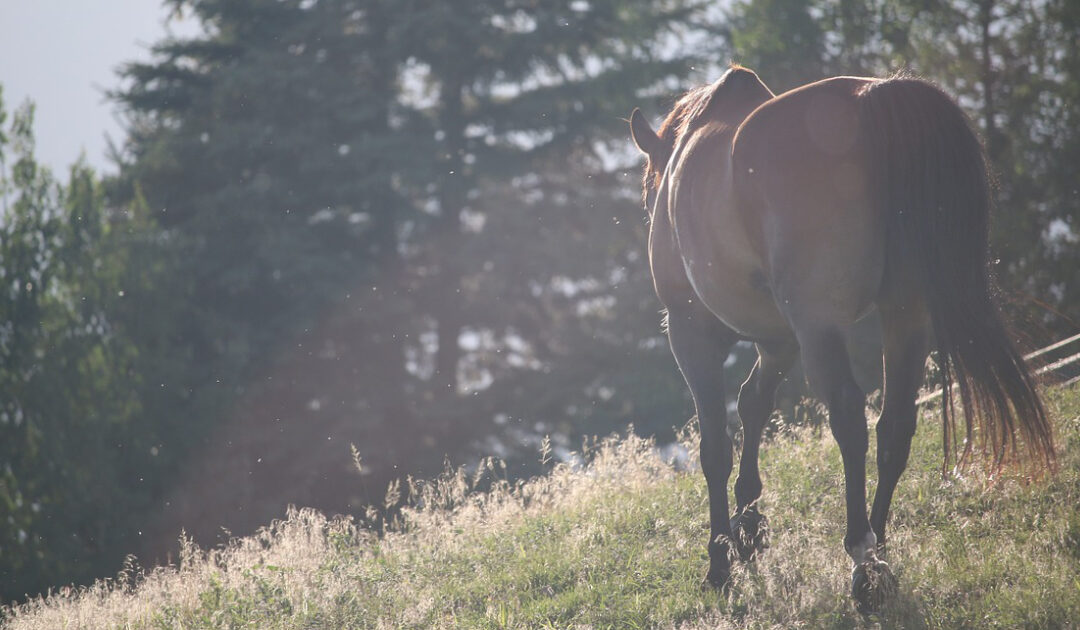
by Bettina Shultz-Jobe, LPC, NBCC | May 7, 2021 | Equine Assisted Trainings, The Latest in Equine Assisted Therapy and Learning
The recent global pandemic forced us to. . .
Pause.
Reflect. Connect. Cry a little (or a lot depending on the day!). Curse a bit (okay, so maybe a lot some days!).
Pause and reflect and connect some more. . .
Then evolve.
Okay, so I can only speak for myself when I say that the Pandemic resulted in a decent amount of “curse crying” – a coping mechanism I don’t necessarily recommend, professionally speaking, but do, personally, find quite effective at times. Truly though, this transformation was at times painful for the entire NL team. Even though the caterpillar’s story of transformation and loss was already near and dear to my heart, I now have a more embodied understanding of the plight of the butterfly.
All of this said, the pause, the reflection, the connection (and the blood, sweat, and tears. . . AND cursing!) allowed us to soar to new heights—and inspired us to adapt our teachings, trainings, and events to allow for transformative change in the larger Equine Assisted Services (EAS) community.
At Natural Lifemanship, we are designing a better way to equip students with the knowledge, skills, and experiences necessary for deep healing—allowing for greater access that meets each student where they are.
Looking back…
We were, and are proud of the progress we have helped to make in the field of Equine Assisted Services (EAS). In finding unique and powerful ways of working with clients and horses based on principles of connection and healthy relating, over ten years ago my husband, Tim Jobe, and I chose to begin equipping other professionals to expand the reach of EAS’s potential for healing.
The world could benefit from more practitioners in the field—we recognized this.
After 10 years of guided in-person trainings, we faced an unforeseeable obstacle. A global pandemic. With just days notice, people throughout the world found themselves indoors, and travel and in-person meetings came to an abrupt end. As the need for support, healing, growth, and wellness grew, so too did the possibility our doors would remain closed for good. (Hence the aforementioned tears and cursing!)
This was not an option for us!
Our little field offers some of the safest and most effective trauma treatment available. Period. People needed competent, connected, and impassioned practitioners more than ever.
MORE THAN EVER.
And mental health professionals, equine professionals, and others in the healing professions needed more support than ever!
MORE THAN EVER!
Moving forward…
After reflecting on the needs of our clients and students, we chose to make our trainings accessible from home. We redesigned our popular *TF-EAP and **TI-EAL based Fundamentals training to be taken virtually, but with a personalized experience that provided guided feedback, one-on-one meetings, and experiential learning. All of which could be completed from home.
To our delight…we found that we were able to provide more content, more resources, and more guidance than ever before. The results showed that many of our students not only thrived, but preferred the virtual fundamentals over our previous in-person training.
In 2020 we also started a scholarship fund and in 2021 we have awarded over $16,000 in scholarships and hope to award more as the year progresses! We are seriously committed to making our trainings as accessible as possible!
*Trauma Focused Equine Assisted Psychotherapy
**Trauma Informed Equine Assisted Learning
Our New & Better Normal
Our greatest challenge in redesigning our trainings was the recognition that we needed to provide various options for the unique needs of our students. We believed that a temporary solution, such as a few online courses, would not provide students with the in-depth education they needed and deserved.
If we were to ensure that our students were fully prepared to work with clients in an EAS setting, we needed to think big—and we did.
Our team came together and designed the most extensive EAS (Equine Assisted Services) training available, with the option of FULLY completing the program from home.
Fundamentals of Natural Lifemanship—Redesigned
Prior to Covid, our Fundamentals of NL training was impactful in that it allowed our students to gain the foundational knowledge and skills needed to engage in the EAP/L process—using the principles of Natural Lifemanship. Actually, I know I’m biased, but our pre-pandemic trainings were excellent!
It’s just that post-pandemic they’re EVEN BETTER!
Today, the Fundamentals of NL training is so much more extensive. We’ve created an 8-week curriculum that dives much deeper into the science of trauma, attachment, and somatics, and provides an immense amount of content that simply can’t be covered, digested, and embodied during a two or three day in-person training.
Nowadays, IF you choose to do in-person training with us (more on this below) you get significantly more time doing the stuff that simply can’t be done online – building nuanced relationship with horses. More time online means more time to experience the power of the horse-human relationship. More time online means that when you come to us you are WAY better prepared to get busy and do some experiencing!
What’s more? Even online we are still able to give individualized guidance and experiential learning exercises that we review for feedback. Students benefit from taking the training in group settings, and interacting with one another—as well as the convenience of working from home with their own horses.
Given that each student has a unique set of circumstances, we provide the following training paths:
The Foundational Fundamentals is a comprehensive introduction to NL for those who may not have access to horses, will not be pursuing certification, or prefer to complete their experiential work in-person by adding on the Fundamentals Practicum, which is our in-person training experience. This is a great option for those who are completely new to Natural Lifemanship or need a refresher.
The Core Fundamentals is designed for people who have access to horses and who want to be able to say they are NL Level 1 trained. In taking this training, students move closer to completing NL certification.
Our Certification Jumpstart option allows students to jumpstart the certification process. Not only does this training count toward some of the certification requirements, it also comes with a bundle deal including a one-year NL professional membership, certification enrollment fee, two personal face-to-face consultations on Zoom––all of which are required for certification. This is the greatest bang for the buck if you know you want to get certified in NL.
What about the hands-on experience?
We fully understand the importance of providing an experiential component to our trainings. After all, what good is a practitioner who has yet to practice? We knew it would be a challenge to create a hands-on learning experience that could be completed from home. . . so we came up with the following solutions—and we couldn’t be happier.
Here are the THREE ways to complete the experiential work required for those seeking certification or wishing to claim that they are NL Level 1 trained. They are. . .
The At Home Experience in which students complete several video assignments and receive feedback and guidance from NL trainers. This experience does require that students have access to a horse.
The In-Person Experience in which students attend one of many in-person practicums throughout the United States and practice their skills and knowledge with in-the-moment guided feedback from our experienced and intuitive NL trainers. (Students must attend the Fundamentals of NL prior to attending)
Or you can do a combination of the two—for those who really want to dive deep and get all of the experience possible.
Our In-Person Practicum
We understand that many people in our field prefer an intimate and interactive in-person training environment so we designed the Fundamentals Practicum to be an unforgettable training experience that allows students to build on their virtual learning experience through hands-on work utilizing the Natural Lifemanship principles. Most of the didactic learning is done online in the Fundamentals of NL leaving significantly more time and space to truly embody the knowledge and skills gained.
We are currently offering several Fundamentals Practicums throughout the year that are hosted at our partner sites scattered throughout the country, making this experience more accessible for everyone.
By the way, in 2021 we adopted the same training structure for our NL Intensive training making it possible to get fully certified in NL from home! The NL Intensive is virtual. There are two options to meet your needs: Foundational Intensive and Core Intensive. The experiential portion of the Intensive training can be done at home or in-person at an Intensive Practicum.
At Natural Lifemanship, we believe that leading means innovating, inspiring, adapting, and evolving—to meet the needs of our compassionate and impactful students as well as our communities, who are in need of deep healing.
While our trainings have evolved to better meet your needs, our principles remain the same. Every training experience through Natural Lifemanship continues to be centered around building healthy relationships and deep connections, based on mutual trust and respect—for EAS practitioners, clients, and horses.
Learn more by watching our latest webinar, “Our New and Better Normal.”
Learn more about the Natural Lifemanship way…
#1 Take some of our courses. We offer many low cost, single purchase courses and videos for those just wanting to get an idea of what’s out there. Many of our courses offer CE credits through NBCC and NAADAC. Many courses are also part of NL Membership or can be purchased by members at steep discounts. Check out our courses here.
#2 Follow along for FREE! We offer an array of free content online through webinars, blogs, and videos – you can do any or all of the following to stay connected and up to date on NL happenings!
- Visit our website naturallifemanship.com to explore blogs and other content. Seriously, so much can be gleaned from our blogs!
- Sign up for a free introductory membership and gain access to educational videos and a new free video each month.
- Subscribe to our newsletter to be notified of news, blogs, trainings, etc.
- Like and Follow our Facebook page and Instagram – we share videos, pictures, articles, and engage in thoughtful discussions.
- The Trauma Focused Equine Assisted Psychotherapy Networking Group on Facebook is also a valuable resource. This group is managed by NL trainers, but is open to ALL. Such great conversations happen in this group!
- Follow our YouTube Channel for free video content! This is a great place to begin understanding how the relationship between horse and person progresses, organically and over time, utilizing NL principles. Watch this video first and then follow the progress made with Annie and Abilene.
We look forward to supporting you as you grow professionally and heal personally—so you can support others.

by Laura McFarland | Apr 16, 2021 | The Latest in Equine Assisted Therapy and Learning
In December 2020, The Journal of Alternative and Complementary Medicine published an article entitled, “Optimal Terminology for Services in the United States That Incorporate Horses to Benefit People: A Consensus Document.”
We at the Natural Lifemanship Institute very much appreciate the authors’ timely work and its importance to our field, to your businesses, and most importantly to the clients you serve. They attempt to address a significant need in the field through a process of inquiry and consensus.
Seriously y’all this is a big deal – leaders (and competitors) in our field came together in a TWO YEAR process of discussion, exploration, research, and collaboration, because, like you, they care about our field, our businesses, and our clients.
We were glad to see that this article has been circulating on social media a bit, but we also realize that it’s an academic article and it’s long! Since we think it’s super important that you read this article and discuss it with us, I wrote up this lovely summary for you! I kinda geek out on these kinds of things, so it was truly a pleasure. 🙂
The purpose of this blog is to provide a concise summary of the article and its recommendations with the hopes of promoting ongoing dialogue amongst our members and others who partner with horses to help people. We want to hear from you! Please join us on Facebook and tell us what you think!
As stakeholders ourselves we have been engaging in lots of internal dialogue about the recommendations and will be publishing an official response in the coming weeks. Our discussions with you will inform our decisions.
If you are interested in being notified when we have posted our response, you may request to be notified, here.
Article Citation
Wood, W., Alm, K., Benjamin, J., Thomas, L., Anderson, D., Pohl, L., & Kane, M. (2021). Optimal terminology for services in the United States that incorporate horses to benefit people: a consensus document. The Journal of Alternative and Complementary Medicine, 27(1), 88-95.
Click here to download the article.
Article Summary
Optimal Terminology for Services in the United States that Incorporate Horses to Benefit People: A Consensus Document (Wood et al., 2021)
The Consensus Process in a Nutshell
A working group of representatives from national organizations in the field of equine-assisted services participated in a 2-year process for the purpose of recommending terminology to be used and to be discontinued in the field.
The grant-funded project was motivated by the recognition that unclear and imprecise use of terminology in the rapidly expanding and diverse field of services incorporating horses to help humans is problematic and potentially damaging. Ambiguous terminology creates confusion and inadequate protection for consumers, obstacles to reimbursement and research, and misinformed policies and practices.
The six-step collaborative process started with an exhaustive search of sites, databases, and literature to identify the most commonly used terms in the field. The authors listed 12 distinct types of equine-assisted services represented under 3 broad categories of therapy, learning, and horsemanship. Next, they developed and disseminated a survey asking stakeholders in the field to rate the relative usefulness of each term. A 2 ½ day professionally facilitated summit was then convened, bringing in additional stakeholders, to discuss the results and to produce a draft of recommendations. The draft underwent review and revision by summit members as well as additional stakeholders to produce the final recommendations that are shared in the article.
The categories themselves, a description of the types of services within each category, and the expertise and credentials required of service providers are summarized in the Nuts & Bolts section below.
The Authors’ Recommendations in a Nutshell
- Equine-assisted Services is the optimal unifying term when referring to two or more services. It is too imprecise to be used to describe one program or distinct type of service.
- Therapy services (5 distinct types include: counseling, occupational therapy, physical therapy, psychotherapy, and speech-language pathology) should use therapy-first language (e.g., physical therapy using equine movement, psychotherapy incorporating horses, occupational therapy in equine environments). Reasons for emphasizing therapy-first language are outlined in the Nuts & Bolts section below.
- Equine-assisted learning (3 types of non-therapy services): Equine-assisted learning in education, equine assisted learning in organizations, and equine-assisted learning in personal development.
- Horsemanship (4 types of non-therapy services): Adaptive equestrian sport, adaptive riding or therapeutic riding, driving, and interactive vaulting.
- Discontinue the use of problematic terminology, including: equine therapy, equine-assisted activities and therapies, equine-assisted therapy, equestrian therapy, hippotherapist, hippotherapy clinic or program, horse therapy, horseback riding therapy, and therapy riding.
NUTS & BOLTS of the Article
WHAT
The article describes the structure and outcomes of a two-year consensus-building process. The purpose of this process was to create a set of recommendations for terminology used when referring to services (within the U.S.) that incorporate equines to benefit people. Recommendations included both the adoption of optimal terminology and the discontinuation of terminology the working group found to be problematic.
WHO
The process was undertaken by a working group (the authors, listed below) comprised of representatives of several relevant national organizations:
- Wendy Wood, PhD, Departments of Animal Sciences and Occupational Therapy , Temple Grandin Center, Colorado State University, Fort Collins, CO, USA
- Kathy Alm, BA, Professional Association of Therapeutic Horsemanship International (PATH, Intl.), Denver, CO, USA
- Joann Benjamin, PT, American Hippotherapy Association, Inc., (AHA, Inc.), Denver, CO, USA
- Lynn Thomas, LCSW, Equine Assisted Growth and Learning Association (EAGALA), Spanish Fork, UT, USA
- Debbie Anderson, AS, Strides to Success, Plainfield, IN, USA
- Lissa Pohl, MA, University of Kentucky, Lexington, KY, USA and Equine Experiential Education Association (E3A), Reno, NV, USA (Click here to watch a Horse Sense webinar with Lissa Pohl as she discusses this article)
- Michele Kane, MA, Major, USMC (Ret.), My Heroes, LLC, Fort Collins, CO, USA
WHY
In the past 30 years, human services incorporating horses have greatly expanded and diversified. As a result, terminology for naming and describing these services has become increasingly unclear and imprecise. The current state of imprecise terminology in our field generates serious problems for stakeholders (including consumers, service providers, funders, researchers, advocates, and regulatory agents). When terminology is vague or misleading, it contributes to confusion, inadequate consumer protection, obstacles to reimbursement, barriers to research, and misinformed policies and practices, among other adverse effects.
HOW
The consensus-building process was initiated in 2018 and spanned two years. The process consisted of 6 steps:
- PATH obtained funding from the Bob Woodruff Foundation to support the consensus building process, and convened a working group of five leaders (authors Wood, Alm, Benjamin, Thomas, and Kane)
- The working group designed and disseminated a survey that asked stakeholders to rate the relative usefulness of the most commonly used terms. The first round of consensus occurred at this step, and consisted of the following sub steps:
- Before developing the survey, the team had to identify and agree on the most commonly used terms in the field. To do this, they conducted an extensive and systematic search of websites, databases and literature, including books and peer-reviewed journal articles. They used over 45 search criteria related to equine- and animal-assisted services and interventions. Nine databases were searched, returning 158 books and peer-reviewed journal articles. This literature was then examined to identify the terms that were used. The terms were entered into an Excel database for the purpose of comparing and contrasting their frequencies of use. The team divided the work and ultimately reached consensus on the most commonly used terms.
- Once a list of commonly used terms had been compiled, the working group collaborated with experts in survey research to design, develop and approve the final survey.
- The survey was distributed through:
- AHA, Inc.
- E3A
- EAGALA
- Equus Foundation
- PATH Intl.
- Directly to ~500 recipients of services, parents, or caregivers
A total of ~16,156 surveys were distributed with a return of 1,745 (or 10.8%) useable surveys, which made up the dataset.
Survey design, research questions, analysis, and key findings are not included in the article but may be obtained.
- A professionally facilitated 2 ½ day terminology summit was held. The attendees (called the summit group) included the members of the working group plus 10 individuals chosen for their extensive experiences and perspectives, representing: AHA, Inc., Bob Woodruff Foundation, Certification Board for Equine Interaction Professionals (CBEIP), EAGALA, E3A, PATH, Intnl, and the U.S. Department of Veterans Affairs. The summit group produced an initial framework of recommendations.
- The working group developed a first draft of recommendations. Summit attendees approved the draft as suitable for further review by leaders and board members of the represented organizations.
- The working group considered all received reviews and finalized their terminology recommendations.
- The working group submitted final recommendations to other summit attendees for approval or disapproval, as well as to the Boards of Directors of eight relevant national organizations, who were asked to approve or disapprove the recommendations that were relevant to them. These organizations included:
- AHA, Inc.
- American Horse Council (AHC)
- Certified Horsemanship Association (CHA)
- CBEIP
- EAGALA
- E3A
- Horses and Humans Research Foundation (HHRF)
- PATH, Intl.
RESULTS
As a result of the 6-step consensus-building process, outlined above, the working group identified and organized 12 types of distinct types of services (see below) and produced the recommendations that follow.
12 distinct types of equine-assisted services were identified under 3 broad categories:
| Equine-assisted Services |
| THERAPY |
LEARNING |
HORSEMANSHIP |
| · Counseling
· Occupational therapy
· Physical therapy
· Psychotherapy
· Speech-language pathology |
· Equine-assisted learning in education
· Equine-assisted learning in organizations
· Equine-assisted learning in personal development |
· Adaptive equestrian sports
· Adaptive riding or therapeutic riding
· Driving
· Interactive vaulting |
Recommended Terminology
- Recommended optimal unifying term: Equine-assisted Services (EAS)
- Refers to multiple services in which professionals incorporate horses/equines to benefit people. Each distinct service constitutes a type of EAS; but the inclusive term, EAS, alone does not suffice as a description for a particular service when it is marketed to consumers.
- Therapy
- Licensed therapy professionals may incorporate horses in each of the five distinct therapies listed in the table above.
- These professionals work within the scope of their practice and particular discipline.
- Best practice dictates that they obtain specialized training focused on incorporating interactions with horses, equine movement, or the equine environment into the individualized plans of care of those receiving therapy.
- These professionals incorporate horses within treatments or interventions to help address individualized goals, and improve overall function, health, and wellness.
- They may or may not work with equine professionals or other assistants for risk management and other purposes.
- Therapy-first language is recommended to refer to any one of the types of therapies identified. The terminology must precisely identify the exact therapy (e.g., physical therapy, psychotherapy). Equine related descriptors can then be added. Examples:
- Physical therapy using equine movement
- Psychotherapy incorporating horses
- Occupational therapy in an equine environment
- Rationale for using therapy-first language:
- Emphasizes licensed therapy professionals who determine how best to implement particular therapies while also acknowledging the potential of the horse to enhance therapeutic outcomes.
- After completing discipline-specific evaluations, the therapists develop treatment plans for achieving goals and specify tools, strategies or interventions, which may include how best to incorporate the horse.
- Therapy-first language reflects the fact that licensed therapy professionals have many options available to them, the incorporation of the horse being one of them.
- Non-specific terms are problematic (see #5 below)
- Learning
- Specially trained or certified professionals may incorporate horses in 3 distinct types of nontherapy services:
- Equine-assisted learning in education
- Focuses on academic skills, character development, and life skills such as problem-solving and critical thinking.
- Professionals providing services have expertise related to learning theory and teaching methodology.
- Work is with schools and school systems to help integrate educational strategies that support individual education plans and academic remediation.
- Equine-assisted learning in organizations
- Assists members of organizations build effective teams and leadership, and improve work dynamics and performance.
- Professionals providing services have expertise related to organizational theory, team building, strategic planning, or leadership development.
- Various approaches or strategies, such as executive coaching, team-building, or group retreats, may be integrated to address the needs of clients.
- Equine-assisted learning in personal development
- Assists individuals and groups in discovering new ways to face life challenges and opportunities by developing skills in effective problem-solving, decision-making, critical and creative thinking, and communication.
- Professionals providing services have expertise in facilitation, coaching, and teaching. They clearly understand how their services differ from psychotherapy and counseling.
- Various approaches or strategies, including personal coaching, and wellness-related activities, may be integrated to address the needs of clients.
- Horsemanship
-
- Equine professionals may offer four distinct non-therapy services that are adapted from traditional equine disciplines of horseback riding, driving, and vaulting, to serve clients with diverse needs.
- Equine professionals providing these services have specialized training or certifications to provide these services to individuals and groups with diverse needs. They require competencies in adapting equipment, the equine environment, and teaching techniques to match the abilities and needs of participants. They develop lesson plans that may involve riding, driving, vaulting, or ground-based activities to help participants attain individualized horsemanship skills and allow for the naturally healthful benefits of riding and other horsemanship activities to occur.
- The four distinct non-therapy services include:
- Adaptive equestrian sport
- Prepares people with diverse needs to participate in events and competitions in equine disciplines such as driving, dressage, reining, and Western or English riding.
- Trainers have expertise related to their specific equine disciplines, competition requirements, possible adaptations for athletes with diverse needs, and representative organizations.
- Benefits of participation may include motivation and opportunities to excel as competitive athletes, physical fitness, self-confidence, and social inclusion.
- Adaptive riding or therapeutic riding
- Focuses on skillfully adapting riding to make the naturally healthful benefits of riding and horses accessible to individuals and groups with diverse needs.
- Instructors have expertise in riding instruction across the continuum of horsemanship skills (groundwork to riding).
- Benefits potentially include physical fitness and improved cognition, emotional, social, or behavioral skills.
- Driving
- Teaches individuals with diverse needs how to safely participate in driving activities with horses. This can occur with many types of vehicles, including carriages, sleighs, or wagons, and can be adapted as needed.
- Instructors have expertise in techniques of safe driving and its instruction.
- Benefits potentially include improved physical fitness or cognitive, emotional, social, or behavioral skills.
- Interactive vaulting
- Engages individuals and groups with diverse needs in movements and gymnastic positions around and on horses and vaulting barrels.
- Instructors have expertise pertaining to the principles and techniques of vaulting.
- Benefits may include improved physical fitness, social skills and communication, problem-solving, and teamwork.
- Recommended discontinuing the use of problematic terminology:
- Equine therapy
- Equine-assisted activities and therapies
- Equine-assisted therapy
- Equestrian therapy
- Hippotherapist and hippotherapy clinic or program
- horse therapy
- Horseback riding therapy and therapy riding
-
The adverse impacts of these terms, which lack clarity and transparency, were identified through the survey and summit. Adverse impacts include:
- Consumers having difficulty identifying and accessing services that best meet their needs
- Payers establishing inaccurate payment codes and requirements based on misinterpretations of terms
- Therapists experiencing funding barriers, denials, and having to request repayment of legitimate therapies
- Journalists using sound bites such as “horse therapy” in stories and thereby obscuring from the public’s view the distinct nature and value of the particular services about which they are reporting
- Promoting terminology inconsistencies in the literature
- No profession, academic degree, professional license, or state regulation was known to exist that supported the above-named therapies as legitimate stand-alone therapies.
- They are potentially legally indefensible for providers and misleading to stakeholders.
The article provides specific reasoning for the discontinuation of each of these problematic terms on pages 92-93.
The terminology recommendations were endorsed by a majority of the summit group and the Boards of Directors of AHC, CHA, E3A, HHRF, and PATH Intl. AHA, Inc.’s Board of Directors disapproved of associating therapies under the same umbrella of equine-assisted services as learning and horsemanship, yet agreed that the other recommendations were a tremendous step forward. AHA’s response can be found here. Votes of the Boards of Directors of EAGALA and CBEIP were pending at the time of the article’s publication.
We have recently confirmed that CBEIP did endorse the terminology recommendations after the article’s publication. Rumor has it that EAGALA did not endorse the terminology recommendations, but we have not yet been able to confirm this.
Summary of Authors’ Main Discussion Points
- The most important recommendation stemming from this process was that stakeholders adopt terminology that precisely and accurately identifies distinct types of services and meaningfully distinguishes between them, and discontinue the use of terminology that is imprecise and potentially inaccurate or misleading. The use of such terminology may benefit the field in a number of ways as well as prevent or mitigate future terminology-related problems.
- The use of the recommended unifying term, Equine-assisted Services, if used as intended to reference two or more services, may also prevent or mitigate terminology-related problems. It must not be reduced to a single homogenous service, however.
- Ongoing questions and challenges:
- There was disagreement on the use of therapy-first language. Licensed therapy professionals who recommended using therapy-first language and discontinuing the use of “equine-assisted” to define therapy (as in as equine-assisted psychotherapy (EAP)) argued that it erroneously implied a different stand-alone therapy from that of psychotherapy itself. Other licensed therapy professionals disagreed and reported that the use of terms such as EAP had not been problematic.
- Some noted that the modifier, equine-assisted, was universally recognized and aligned with widespread uses of animal-assisted and was therefore preferable to terms like equine-facilitated or equine-guided.
- The use of adaptive riding and therapeutic riding were questioned and there was some disagreement regarding the best terms to describe services in which riding was adapted to make the benefits accessible to persons with diverse needs. The historic use of “therapeutic riding” to label any service incorporating horses was rejected. Likewise, the adjective, “therapeutic”, was rejected insofar as it implies that therapeutic riding is a type of therapy. Yet, therapeutic riding is viewed as a highly recognizable term, both nationally and internationally, and has been used for more than half a century. Adaptive riding, a more recent term, aligns with terminology in adaptive recreation and sports while accurately conveying that the activity is adapted. Ultimately, valid preferences for either term were recognized.
- The authors maintain that the article is a living document and they encourage critical evaluations of all recommendations plus ongoing monitoring of any positive or negative impacts of the recommendations.
Curious about the Natural Lifemanship Institute’s response?
Sign up here to be notified when it is released.
Please, please join the conversation on our Facebook page!
Want to learn more? Watch a Horse Sense Webinar in which Lissa Pohl (one of the authors) shares more about this project and this publication.











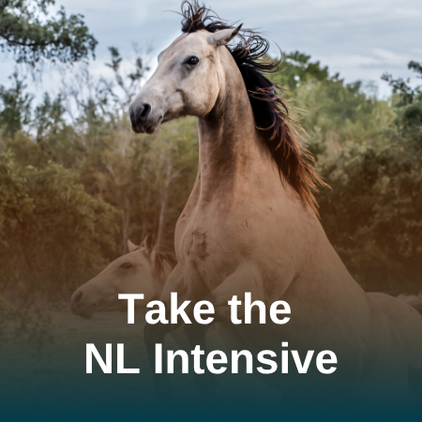
Recent Comments